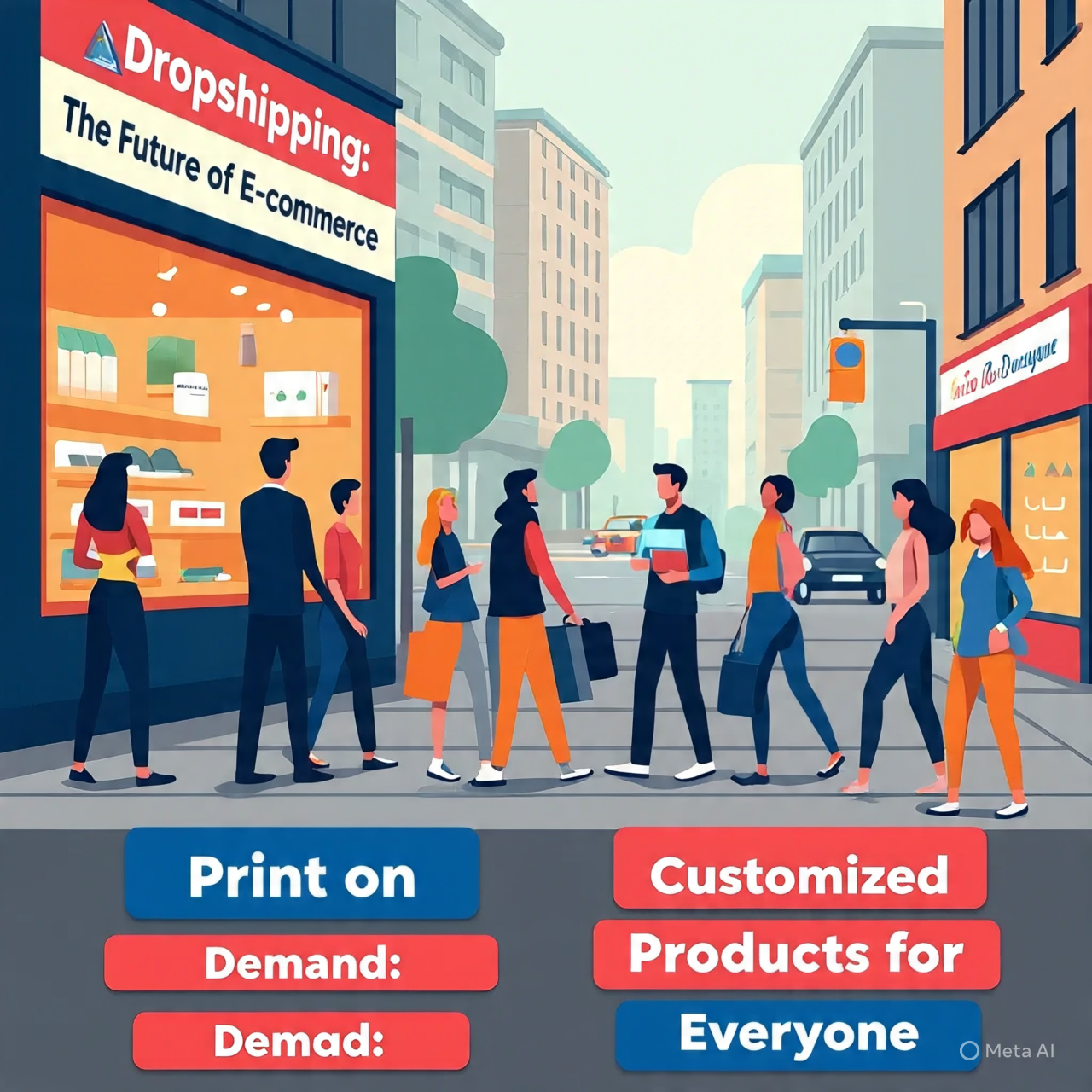Meta Description: Unsure about Dropshipping vs Print on Demand in India? This guide breaks down pros, cons, and platforms to help you choose the best e-commerce model for your business.
Introduction: Navigating E-commerce – Dropshipping vs Print on Demand in India 🇮🇳

The Indian e-commerce landscape is booming, offering unprecedented opportunities for aspiring entrepreneurs. If you’re looking to start an online business with minimal upfront investment in inventory, two popular models often come to mind: Dropshipping and Print on Demand (POD). Both allow you to sell products without holding stock, significantly reducing financial risk. However, they operate on different principles and present unique challenges and advantages, especially when considering the nuances of the Indian market.
For anyone trying to decide between Dropshipping vs Print on Demand in India, understanding their core mechanisms, operational complexities, and potential for success is crucial. This detailed guide will delve deep into both models, breaking down their pros and cons specific to the Indian context. We’ll explore popular platforms, common pitfalls, and offer insights to help you determine which e-commerce strategy is better suited for your entrepreneurial journey in India. Let’s uncover the specifics of Dropshipping vs Print on Demand to help you make an informed decision!
What is Dropshipping?

Dropshipping is an e-commerce fulfillment model where you, the retailer, don’t keep the products you sell in stock. Instead, when a customer places an order on your online store, you purchase the item from a third-party supplier (manufacturer, wholesaler, or another retailer) who then ships the product directly to your customer. You essentially act as a middleman.
How Dropshipping Works:

- A customer places an order on your online store (e.g., on Shopify).
- You receive the order and the payment from the customer.
- You then forward the order to your dropshipping supplier, paying them their wholesale price.
- The supplier ships the product directly to your customer under your brand name (or generic packaging).
- You keep the difference between what you charged the customer and what you paid the supplier.
Pros of Dropshipping in India:
- Low Startup Cost: No need to buy inventory upfront, significantly reducing financial risk.
- Wide Product Selection: You can offer a vast range of products without managing stock.
- Flexibility & Location Independence: Manage your business from anywhere with an internet connection.
- Scalability: Easy to scale up or down as demand changes, without worrying about unsold inventory.
- Easy to Start: Setting up a store and finding suppliers can be done relatively quickly.
Cons of Dropshipping in India:

- Lower Profit Margins: Because you’re acting as a middleman, your profit margin per sale can be thinner compared to traditional retail.
- Inventory Management & Stock Issues: You don’t control the stock; relying on suppliers means you might face out-of-stock issues or delays without immediate knowledge.
- Shipping & Logistics Challenges:
- Delivery Times: International dropshipping can lead to long delivery times to India, causing customer dissatisfaction.
- Customs & Duties: Products imported from abroad might incur customs duties, which can surprise customers or erode your margins if not factored in.
- Reliability: Finding reliable Indian dropshipping suppliers can be a challenge.
- Quality Control Issues: You never physically see the product, making quality assurance difficult. Returns and refunds can become complex.
- High Competition: The low barrier to entry means many players, leading to fierce competition.
Popular Dropshipping Platforms & Suppliers in India:
- Shopify: The leading e-commerce platform for setting up your store.
- WooCommerce: A flexible open-source option for WordPress users.
- Suppliers: Finding reliable Indian suppliers is key. Some emerging platforms include Printrove (though primarily POD), Snazzyway, and local wholesalers on platforms like IndiaMart. Many still rely on international giants like AliExpress (though shipping from China to India has its challenges).
What is Print on Demand (POD)?

Print on Demand (POD) is a variation of dropshipping where you sell custom-designed products like T-shirts, mugs, phone cases, and hoodies. When a customer places an order, the POD supplier prints your design onto the product, packages it, and ships it directly to the customer.
How Print on Demand Works:
- You create a design (or outsource it).
- You upload your design to a POD platform and apply it to various products (e.g., T-shirts, mugs, posters).
- You list these custom-designed products on your online store.
- A customer buys a product from your store.
- The POD supplier receives the order, prints your design onto the product, packages it, and ships it directly to your customer.
- You pay the supplier only for the product and printing service; you keep the profit margin.
Pros of Print on Demand in India:
- No Inventory: Similar to dropshipping, you don’t hold any physical stock.
- Brand Building: You sell unique products with your own designs, allowing for stronger brand identity and customer loyalty.
- Creative Freedom: Perfect for artists, designers, or anyone with unique ideas.
- Higher Profit Margins (Potentially): Since your designs are unique, you can often command better prices than generic dropshipped goods, leading to higher margins.
- Reduced Shipping Complexities (often domestic): Many POD suppliers in India operate domestically, meaning faster shipping times, fewer customs issues, and easier returns compared to international dropshipping.
- Quality Control (Supplier Focus): While you don’t touch the product, the POD supplier specializes in printing quality, offering a more consistent experience than varied dropshipping suppliers.
Cons of Print on Demand in India:
- Reliance on Supplier Quality: The final product quality (print quality, fabric quality) depends entirely on your chosen POD supplier.
- Limited Product Range: While growing, the range of customizable products might be narrower compared to the vast selection in general dropshipping.
- Design Skills Required: You need good design skills or the budget to outsource design.
- Lower Profit per Item (than bulk buying): While better than generic dropshipping, profits are still lower than buying in bulk and self-fulfilling.
- Branding Limitations: Some POD suppliers only offer generic packaging, limiting your brand’s physical presence.
Popular Print on Demand Platforms & Suppliers in India:
- Printrove: One of the most popular and reliable POD suppliers in India. Integrates with Shopify, WooCommerce.
- Blinkstore: Another emerging Indian POD platform.
- CustomInk / Teespring (international but serve India): Though primarily US-based, they have options for international shipping. However, local Indian suppliers are generally preferred for Indian customers.
Dropshipping vs Print on Demand in India: A Head-to-Head Comparison

Let’s compare Dropshipping vs Print on Demand on key factors relevant to the Indian market:
| Feature | Dropshipping in India | Print on Demand in India |
| Product Type | Wide variety of generic products | Custom-designed apparel, accessories, home goods |
| Competition | Very High (for generic, trending products) | High (for popular niches), but unique designs reduce it |
| Profit Margins | Generally lower (due to competition, supplier pricing) | Potentially higher (due to unique designs, brand value) |
| Inventory Risk | Very low | Very low |
| Shipping | Often international, prone to delays, customs, duties | Mostly domestic, faster, fewer customs issues |
| Quality Control | Highly dependent on varied suppliers, less control | Dependent on POD supplier’s print/product quality, more consistent |
| Brand Building | Challenging with generic products | Easier with unique designs and branding |
| Design Skills | Not essential (unless you customize listings) | Essential (or outsource budget) |
| Customer Service | Complex due to supplier dependency, shipping issues | Simpler, often related to product/print quality |
| Marketing Focus | Finding trending products, running ads | Showcasing unique designs, building community |
Insight: The Indian e-commerce market is projected to reach US$150 billion by 2026 (Source: India Brand Equity Foundation – IBEF). This massive growth indicates ample room for both models, but understanding the unique challenges of each is vital. A significant percentage of online shoppers in India prefer Cash on Delivery (COD), which needs to be factored into your payment gateway strategy for both models.
Which is Better for You in India? Dropshipping vs Print on Demand?

The choice between Dropshipping vs Print on Demand in India largely depends on your skills, interests, and business goals:
Choose Dropshipping if:
- You want to offer a very wide variety of products without dealing with design.
- You are excellent at product research and finding trending items quickly.
- You are good at digital marketing and running effective ads to drive traffic.
- You are prepared to manage complex logistics (international shipping, customs, refunds).
- Your goal is to quickly test multiple product niches with minimal investment.
- You are comfortable with potentially lower profit margins per sale.
Choose Print on Demand if:
- You have a creative flair or access to unique designs (graphic design skills).
- You want to build a strong brand around unique products.
- You prefer simpler shipping logistics (often domestic).
- You are focused on quality control related to printing and product material from a dedicated supplier.
- You aim for potentially higher profit margins on unique items.
- You are passionate about a niche (e.g., specific fandom, local culture, unique humor) where custom apparel or accessories would thrive.
Real-life Example: An Indian entrepreneur, Rohan, started a POD store selling T-shirts with relatable local slang and cultural references. His unique designs resonated with the Indian youth, leading to higher engagement and better margins compared to his previous generic dropshipping attempt, which struggled with long shipping times from China. This shows the power of niche and local relevance in POD.
Starting Your E-commerce Journey in India

Regardless of whether you choose Dropshipping vs Print on Demand, these steps are crucial:
- Market Research: Identify your niche, target audience, and product demand. Understand local trends.
- Choose Your Platform: Shopify or WooCommerce are popular choices for setting up your online store.
- Find Reliable Suppliers: This is critical. For dropshipping, research Indian wholesalers or reliable international suppliers. For POD, partner with a reputable Indian POD supplier like Printrove.
- Payment Gateways: Integrate popular Indian payment gateways like Razorpay, PayU, or Cashfree. Don’t forget to offer Cash on Delivery (COD), which is vital for the Indian market.
- Marketing & Branding: Build a strong brand identity. Use social media marketing (Instagram, Facebook), local SEO, and paid ads to reach your audience.
- Internal Link: Get ideas for generating traffic with our guide: [10 Legit Side Hustles to Start from Home in the US & India] (which also covers e-commerce basics).
- Internal Link: Once your income grows, learn to manage it with our tips on: [How to Make Passive Income Online in 2025] (as e-commerce can evolve into a semi-passive stream).
Conclusion: Empowering Your E-commerce Decision in India

The debate between Dropshipping vs Print on Demand in India doesn’t have a single “better” answer; rather, it’s about finding the best fit for your entrepreneurial vision and resources. Both models offer fantastic low-risk entry points into the thriving Indian e-commerce market. Dropshipping provides broader product access but comes with supply chain complexities. Print on Demand offers unique branding opportunities and often simpler domestic logistics but requires design creativity.
By carefully weighing the pros and cons specific to the Indian context, considering your strengths, and committing to diligent market research and customer service, you can build a successful online business. Take the leap, learn along the way, and contribute to India’s exciting digital commerce story!
Call to Action: Which model resonates with you more for starting your online business in India? Share your thoughts in the comments below, and start building your e-commerce dream today!

